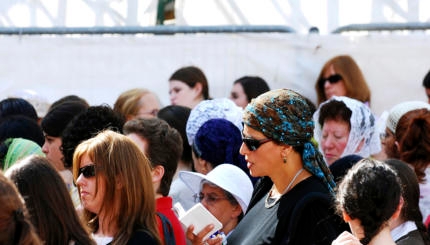Occasionally, a book about Jewish prayer will tell you that Judaism discourages spontaneous prayer. That magic of Jewish prayer, the book will say, lies in mastering the discipline of repeating a fixed liturgy. Only through repetition can we gradually open ourselves to the spiritual mentoring of our ancestral authors.
This, gentle readers, is complete nonsense.
Judaism encourages spontaneous prayer and liturgical prayer.
The dual focus is amply described in the Talmud and in Hasidic literature. Our siddur, the anthology of 3,000 years of spiritual poetry that serves as our liturgical text, was never meant to abolish spontaneous prayer.
For a Shabbat prayer leader, it’s not easy to deliver spontaneous prayer week after week. Rabbinic schools do not offer a core course in the skill. Here’s my confession, though: offering spontaneous prayer is my favorite part of the entire service.
Over the last three years, as I have gained confidence, I have spoken aloud, mostly in English, some 150 different prayers for peace and 150 different prayers for healing.
These prayers are not prepared in advance. They emerge from the raw materials of congregational life and the content of that week’s service or Torah reading. They are not preserved afterwards. As I return to ordinary consciousness, the details fade.
If I could, I would collect the healing prayers into a book called “Fifty-Four Meditations: Healing Prayers for Each Torah Portion.” But I can’t. The prayers do not form themselves when I sit in the presence of a text – only when I stand in the presence of people.
Maybe there’s a bit of mystery to this practice.
More likely, it depends on a unique intersection of skills.
Some of the skills are taught in rabbinic school: Formulating ideas into words, quickly. Reading Biblical Hebrew with understanding. Giving multiple translations of Hebrew word roots, so that the words become metaphors and stimulate new interpretations.
And some of the skills are not taught in rabbinic school: Quieting one’s own mind to receive feelings from those around you. Opening to the presence of God within a group. Learning to put spiritual perception into words. Most of this I learned studying Spiritual Direction in a Christian seminary. (A handful of Jewish spiritual direction programs, such as ALEPH Hashpa’ah, and Lev Shomea, also teach it).
Why are these skills not often taught? Perhaps it’s connected to Rebecca Sirbu’s observation that Jewish communities often do not talk about God. We lack vocabulary for discussing the experience.
More precisely, our God-vocabulary is very strong in some areas and weak in others.
Kabbalistic teachers speak of four worlds of reality and consciousness: assiyah, the world of action; yetzirah, the world of emotion; beriyah, the world of intellect; and atzilut, the world of spirit.
Contemporary Judaism is rich in discourse about God in the world of action. We speak of ethical mitzvot, ritual mitzvot, and tikkun olam, repair of the world. We easily understand ourselves to be fulfilling a divine ethical imperative through our deeds. We also navigate well in the world of intellect. Many of us can explain with skill why we are theists, atheists, or agnostics.
But we do less well in the areas of emotion or spirit. It’s easier, for example, for us to argue that God doesn’t exist than to explore a feeling of being abandoned by Divine love or protection. And many of us theists have no vocabulary at all for the experience of dwelling in God’s Presence.
Most of us can pray spontaneously, but few of us know how to talk about it, teach about it, or do it authentically while serving as a prayer leader. We may enjoy stories about the great Hasidic masters who do it well, but rarely think about the skill set that would make it accessible to us.
Is spontaneous, heartfelt, accessible prayer something you would like to explore? How can you start the discussion in your circles?
Image: onmounthoreb.com. Cross-posted at OnSophiaStreet.
For more on prayer and spontaneity, click here.
Hasidic
Pronounced: khah-SID-ik, Origin: Hebrew, a stream within ultra-Orthodox Judaism that grew out of an 18th-century mystical revival movement.
Shabbat
Pronounced: shuh-BAHT or shah-BAHT, Origin: Hebrew, the Sabbath, from sundown Friday to sundown Saturday.
Talmud
Pronounced: TALL-mud, Origin: Hebrew, the set of teachings and commentaries on the Torah that form the basis for Jewish law. Comprised of the Mishnah and the Gemara, it contains the opinions of thousands of rabbis from different periods in Jewish history.
Torah
Pronunced: TORE-uh, Origin: Hebrew, the Five Books of Moses.



